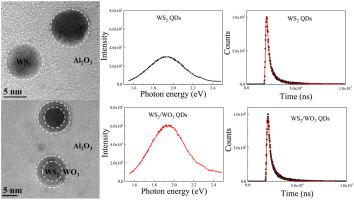当前位置:
X-MOL 学术
›
J. Alloys Compd.
›
论文详情
Our official English website, www.x-mol.net, welcomes your
feedback! (Note: you will need to create a separate account there.)
Enhanced photoluminescence of WS2/WO3 heterostructural QDs
Journal of Alloys and Compounds ( IF 5.8 ) Pub Date : 2020-09-01 , DOI: 10.1016/j.jallcom.2020.155066 Chengwu Zou , Mingyue Chen , Xingfang Luo , Hang Zhou , Ting Yu , Cailei Yuan
Journal of Alloys and Compounds ( IF 5.8 ) Pub Date : 2020-09-01 , DOI: 10.1016/j.jallcom.2020.155066 Chengwu Zou , Mingyue Chen , Xingfang Luo , Hang Zhou , Ting Yu , Cailei Yuan

|
Abstract Tungsten disulfide (WS2), as one of the typical transition-metal dichalcogenides (TMDCs), possesses attractive physical properties and widely potential applications, especially in optoelectronic devices. However, the low photoluminescence (PL) quantum yield (QY) still limits the practical applications of WS2. In this paper, WS2/WO3 heterostructural (core/shell) quantum dots (QDs) are prepared by pulsed laser deposition (PLD) and rapid thermal annealing (RTA) techniques, which exhibit PL enhancement and higher PLQY. The improvement may originate from the WO3 shells, which act as passivation layer to relieve the surface defect-states and many-body effects. Our work may provide a new pathway to utilize the heterostructural QDs to design physical properties of TMDCs, and these heterostructural QDs are promising candidates in optoelectronic applications such as photodetectors and light-emitting devices.
中文翻译:

WS2/WO3 异质结构量子点的增强光致发光
摘要 二硫化钨(WS2)作为典型的过渡金属二硫属化物(TMDCs)之一,具有吸引人的物理性质和广泛的潜在应用,特别是在光电器件中。然而,低光致发光(PL)量子产率(QY)仍然限制了WS2的实际应用。在本文中,WS2/WO3 异质结构(核/壳)量子点(QDs)是通过脉冲激光沉积(PLD)和快速热退火(RTA)技术制备的,具有 PL 增强和更高的 PLQY。这种改进可能源于 WO3 壳,它充当钝化层以减轻表面缺陷状态和多体效应。我们的工作可能为利用异质结构量子点设计 TMDCs 的物理特性提供一条新途径,
更新日期:2020-09-01
中文翻译:

WS2/WO3 异质结构量子点的增强光致发光
摘要 二硫化钨(WS2)作为典型的过渡金属二硫属化物(TMDCs)之一,具有吸引人的物理性质和广泛的潜在应用,特别是在光电器件中。然而,低光致发光(PL)量子产率(QY)仍然限制了WS2的实际应用。在本文中,WS2/WO3 异质结构(核/壳)量子点(QDs)是通过脉冲激光沉积(PLD)和快速热退火(RTA)技术制备的,具有 PL 增强和更高的 PLQY。这种改进可能源于 WO3 壳,它充当钝化层以减轻表面缺陷状态和多体效应。我们的工作可能为利用异质结构量子点设计 TMDCs 的物理特性提供一条新途径,











































 京公网安备 11010802027423号
京公网安备 11010802027423号